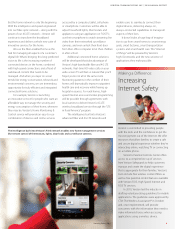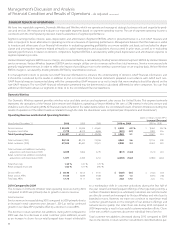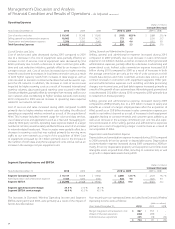Verizon Wireless 2010 Annual Report Download - page 18
Download and view the complete annual report
Please find page 18 of the 2010 Verizon Wireless annual report below. You can navigate through the pages in the report by either clicking on the pages listed below, or by using the keyword search tool below to find specific information within the annual report.
We expect broadband penetration to positively impact our Mass Markets
revenue and subscriber base, but we expect to continue to experience
declining revenues in our Wireline segment primarily due to access line
losses as a result of wireless substitution and current economic condi-
tions. We also expect to experience period to period declines in reported
revenue due to the transaction with Frontier described above.
We expect continued expansion of strategic services revenue as we derive
additional revenues from cloud, security and other solutions-based ser-
vices and customers continue to migrate their services to Private IP and
other strategic networking services.
Operating Costs and Expenses
We anticipate that our overall wireless operating costs will increase as a
result of the expected increase in the volume of smartphone sales, which
will result in higher equipment costs. We expect that the impact of these
increased operating costs will cause a decline in our near-term Verizon
Wireless Segment earnings before interest, taxes, depreciation and amor-
tization (EBITDA) margins. However, we expect to continue to achieve
other operating cost efficiencies through a number of cost savings initia-
tives to help control our overall operating costs. In addition, labor costs
are expected to decrease in our Wireline segment as a result of head-
count reductions, which will be partially offset by increased content costs
for video in our growth businesses.
Capital Expenditures
Our 2011 capital program includes capital to fund advanced networks
and services, including FiOS and LTE, the continued expansion of our
core networks, including our IP and wireless Evolution-Data Optimized
(EV-DO) networks, maintenance and support for our legacy voice net-
works and other expenditures. Additionally, during 2010 we substantially
completed the initial FiOS deployment program. The amount and the
timingoftheCompany’scapitalexpenditureswithinthesebroadcat-
egories can vary significantly as a result of a variety of factors outside
our control, including, for example, material weather events. We are not
subject to any agreement that would constrain our ability to control our
capital expenditures by requiring material capital expenditures on a des-
ignated schedule or upon the occurrence of designated events. Capital
expenditures declined in 2010 compared to 2009. We believe that we
have sufficient discretion over the amount and timing of our capital
expenditures on a company-wide basis that we can reasonably expect
2011 capital expenditures to be flat or lower than 2010.
Cash Flow from Operations
We create value for our shareowners by investing the cash flows gener-
ated by our business in opportunities and transactions that support our
strategic imperatives, thereby increasing customer satisfaction and usage
of our products and services. In addition, we have used our cash flows to
maintainandgrowourdividendpayouttoshareowners.Verizon’sBoard
ofDirectorsincreasedtheCompany’squarterlydividendby2.6%during
2010, which was the fourth consecutive year in which we have raised our
dividend. Net cash provided by operating activities for the year ended
December 31, 2010 of $33.4 billion increased by $2.0 billion from $31.4
billion for the year ended December 31, 2009.
Other
We do not currently expect that legislative efforts relating to climate
control will have a material adverse impact on our consolidated financial
results or financial condition. We believe there may be opportunities for
companies to increase their use of communications services, including
those we provide, in order to minimize the environmental impact of
their businesses.
CONSOLIDATED RESULTS OF OPERATIONS
In this section, we discuss our overall results of operations and highlight
items of a non-operational nature that are not included in our seg-
ment results. We have two reportable segments, which we operate and
manage as strategic business units and organize by products and ser-
vices.OursegmentsareDomesticWirelessandWireline.Inthe“Segment
ResultsofOperations”section,wereviewtheperformanceofourtwo
reportable segments.
Corporate, eliminations and other includes unallocated corporate
expenses, intersegment eliminations recorded in consolidation, the
results of other businesses such as our investments in unconsolidated
businesses, pension and other employee benefit related costs, lease
financing, and divested operations and other adjustments and gains and
losses that are not allocated in assessing segment performance due to
their non-operational nature. Although such transactions are excluded
from the business segment results, they are included in reported consoli-
dated earnings. Gains and losses that are not individually significant are
included in all segment results as these items are included in the chief
operatingdecisionmaker’sassessmentofsegmentperformance.We
believe that this presentation assists users of our financial statements in
better understanding our results of operations and trends from period
to period.
In the following discussion, all prior period results have been adjusted
to reflect the change in accounting for benefit plans (see Note 1 to the
consolidated financial statements). Reclassifications have also been
made primarily to reflect comparable operating results for the spin-off of
our local exchange business and related landline activities in predomi-
nantly rural areas in 14 states, completed in 2010, and in Maine, New
Hampshire and Vermont, completed in 2008, as well as sale of the Alltel
Divestiture Markets.
16
Management’sDiscussionandAnalysis
ofFinancialConditionandResultsofOperations – As Adjusted continued
























